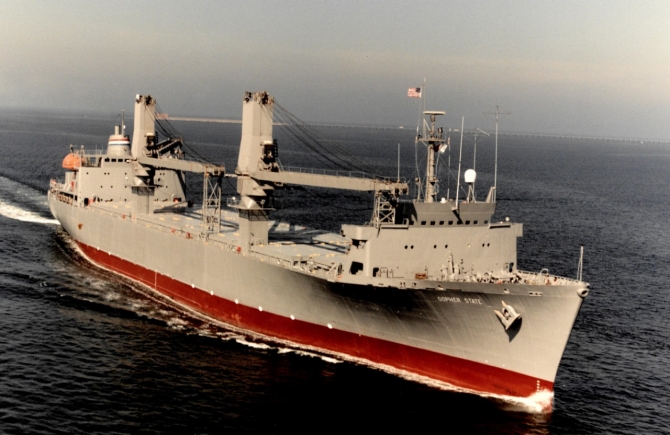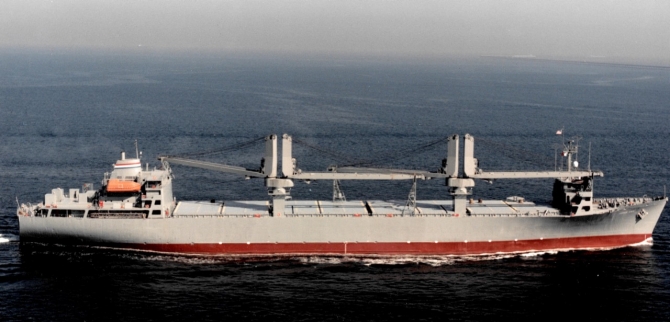Gopher State (T-ACS-4)
1987–
The first U.S. Navy ship named Gopher State, a nickname for the state of Minnesota.
(T-ACS-4: displacement 31,500; length 610'; beam 78'; draft 31'; speed 17 knots; complement 32; armament none; class Keystone State)
Container ship Export Leader (MA-257) was laid down on 26 July 1971 at Bath, Maine, by Bath Iron Works; launched on 8 July 1972; entered service with American Export-Isbrandtsen Lines, Inc., on 22 January 1973; sold to Farrell Lines, Inc., in 1978; acquired by the Maritime Administration in 1982 and served as a test ship for Project Arapaho (primarily a research and development project to demonstrate the feasibility of operating antisubmarine helicopters from merchantmen) while configured with a portable modular aviation facility, logging 178 day and 45 night helicopter landings; laid-up in the James River Reserve Fleet, Va.; renamed Gopher State (T-ACS-4) on 13 June 1986; began conversion on 21 October 1986 to an auxiliary crane ship at Norfolk Shipbuilding & Drydock Corp., Norfolk, Va.; and was placed in service with the Military Sealift Command (MSC) on 12 October 1987.


During 1990, auxiliary crane ships Flickertail State (T-ACS-5) and Gopher State took part in Operation Steel Box—shipping 100,000 U.S. artillery rounds fitted with nerve agents from their bunkers in Germany to Johnston Atoll in the Pacific for storage and subsequent disposal. Flickertail State and Gopher State loaded the lethal munitions at Wilhelmshaven, Germany. On 22 September 1990, they sailed for southern waters, rendezvousing with their escort, guided missile cruiser Bainbridge (CGN-25) — which had deployed from Norfolk on 5 September and visited Portsmouth, England (14–17 September). The convoy crossed the equator on 2 October, rounded Cape Horn on 13 October, and on 22 October rendezvoused with Truxtun (CGN-35) -- that had sailed from San Diego on 16 October -- near the Galapagos Islands at 10° S, 92° W. Bainbridge came about and made for home via the Panama Canal (25–26 October), returning to Norfolk on Halloween. Truxtun and her charges meanwhile continued on westerly courses, rendezvoused with Coast Guard cutter Kiska (WPB-1336), and reached Johnston Atoll. The cruiser and cutter escorted Gopher State into the atoll on 6 November, and she offloaded her cargo. Truxtun returned to sea and faithfully shepherded Flickertail State until Gopher State finished unloading, and then the ships switched tasks. The cruiser subsequently came about and reached Pearl Harbor, Hi., on 14 November. Flickertail State and Gopher State then served in Operations Desert Shield/Desert Storm/Desert Sabre (1990–1991).
Detailed history pending.
Mark L. Evans
5 January 2016


